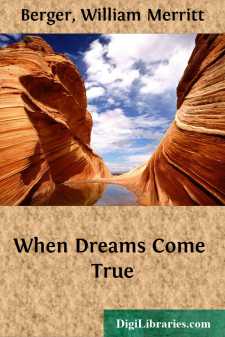Categories
- Antiques & Collectibles 13
- Architecture 36
- Art 48
- Bibles 22
- Biography & Autobiography 813
- Body, Mind & Spirit 142
- Business & Economics 28
- Children's Books 17
- Children's Fiction 14
- Computers 4
- Cooking 94
- Crafts & Hobbies 4
- Drama 346
- Education 46
- Family & Relationships 57
- Fiction 11829
- Games 19
- Gardening 17
- Health & Fitness 34
- History 1377
- House & Home 1
- Humor 147
- Juvenile Fiction 1873
- Juvenile Nonfiction 202
- Language Arts & Disciplines 88
- Law 16
- Literary Collections 686
- Literary Criticism 179
- Mathematics 13
- Medical 41
- Music 40
- Nature 179
- Non-Classifiable 1768
- Performing Arts 7
- Periodicals 1453
- Philosophy 64
- Photography 2
- Poetry 896
- Political Science 203
- Psychology 42
- Reference 154
- Religion 513
- Science 126
- Self-Help 84
- Social Science 81
- Sports & Recreation 34
- Study Aids 3
- Technology & Engineering 59
- Transportation 23
- Travel 463
- True Crime 29
When Dreams Come True
Description:
Excerpt
I
The beauty of midsummer lay upon the land—the mountains and plains of Chihuahua. It was August, the month of melons and ripening corn. High aloft in the pale blue vault of heaven, a solitary eagle soared in ever widening circles in its flight toward the sun. Far out upon the plains the lone wolf skulked among the sage and cactus in search of the rabbit and antelope, or lay panting in the scanty shade of the yucca.
By most persons this little known land of the great Southwest is regarded as the one which God forgot. But to those who are familiar with its vast expanse of plain and horizon, its rugged sierras, its wild desolate mesas and solitary peaks of half-decayed mountains—its tawny stretches of desert marked with the occasional skeletons of animal and human remains—its golden wealth of sunshine and opalescent skies, and have felt the brooding death-like silence which seems to hold as in a spell all things living as well as dead, this land becomes one of mystery and enchantment—a mute witness of some unknown or forgotten past when the children of men were young, whose secrets it still withholds, and with whose dust is mingled not only that of unnumbered and unknown generations of men, but that of Montezuma and the hardy daring Conquistadores of old Spain.
But whatever may be the general consensus of opinion concerning this land, such at least was the light in which it was viewed by Captain Forest, as he and his Indian attendant, José, drew rein on the rim of a broken, wind-swept mesa in the heart of the Chihuahuan desert, a full day's ride from Santa Fé whither they were bound, to witness the Fiesta, the Feast of the Corn, which was celebrated annually at this season.
The point where they halted commanded a sweeping view of the surrounding country. Just opposite, some five leagues distant, on the farther side of the valley which lay below them, towered the sharp ragged crest of the Mexican Sierras; their sides and foothills clothed in a thin growth of chaparral, pine and juniper and other low-growing bushes. Deep, rugged arroyos, the work of the rain and mountain torrents, cut and scarred the foothills which descended in precipitous slopes to the valley and plains below. Solitary giant cactus dotted the landscape, adding to the general desolation of the scene, relieved only by the glitter of the silvery sage, white poppy and yucca, and yellow and scarlet cactus bloom which glistened in the slanting rays of the afternoon sun and the intense radiation of heat in which was mirrored the distant mirage; transforming the desert into wonderful lakes of limpid waters that faded in turn on the ever receding horizon.
Below them numerous Indian encampments of some half-wild hill tribe straggled along the banks of the almost dry stream which wound through the valley until lost in the thirsty sands of the desert beyond.
"'Tis the very spot, Capitan—the place of the skull!" ejaculated José, the first to break the silence. "See—yonder it lies just as we left it!" and he pointed toward the foot of the mesa where a spring trickled from the rock, a short distance from which lay a human skull bleached white by long exposure to the sun.
Instinctively the Captain's thoughts reverted to the incidents of the previous year when he lay in the desert sick unto death with fever and his horse, Starlight, had stood over his prostrate body and fought the wolves and vultures for a whole day and night until José returned with help from the Indian pueblo, La Guna. Involuntarily his hand slipped caressingly to the animal's neck, a chestnut with four white feet and a white mane and tail that swept the ground and a forelock that hung to his nostrils, concealing the star on his forehead; a magnificent animal, lithe and graceful as a lady's silken scarf, untiring and enduring as a Damascus blade. A horse that comes but once during twenty generations of Spanish-Arabian stock, and then is rare, and which, through some trick of nature or reversion, blossoms forth in all the beauty of an original type, taking upon himself the color and markings of some shy, wild-eyed dam, the pride of the Bedouin tribe and is known as the "Pearl of the Desert." The type of horse that bore Alexander and Jenghis Khan and the Prophet's War Chieftains to victory....


